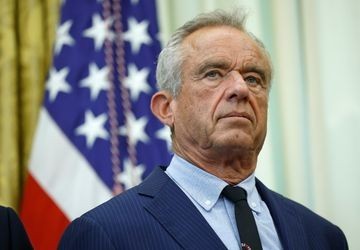Listen to the article
In the wake of Donald Trump’s return to the White House, his administration has begun articulating concerns about wind farms, reviving debates that characterized his previous term. The administration’s stance, spearheaded by Health and Human Services Secretary Robert F. Kennedy Jr., encompasses multiple objections to wind energy infrastructure that span environmental, economic, health, and national security considerations.
During a recent Oval Office event on October 16, where President Trump primarily discussed plans to expand IVF access through workplace benefits, Secretary Kennedy briefly addressed the administration’s position on wind energy. The comments have since sparked renewed scrutiny of the administration’s energy priorities and environmental policies.
The Trump administration has outlined several specific concerns regarding wind farms. Chief among these is the impact on wildlife, particularly bird mortality. Officials cite studies suggesting that wind turbines kill hundreds of thousands of birds annually, though environmental researchers note this figure represents a fraction of bird deaths caused by other human structures such as buildings and power lines.
Economic concerns feature prominently in the administration’s critique. Energy Secretary Doug Burgum has questioned the cost-effectiveness of wind energy, arguing that despite technological improvements, the intermittent nature of wind power necessitates backup generation capacity, potentially offsetting some economic benefits.
“We need to ensure our energy portfolio prioritizes reliability and affordability,” Burgum stated at a recent energy conference. “While renewable technologies continue to advance, we must be clear-eyed about their limitations and total system costs.”
The administration has also raised national security issues, specifically regarding radar interference. Department of Defense officials have expressed concern that wind turbines can create false readings on military radar systems, potentially compromising air defense capabilities in certain regions. The Pentagon has previously worked with wind developers to mitigate these effects, but the administration suggests current solutions are inadequate.
Perhaps most controversial are the health concerns cited by Secretary Kennedy, who has long held unconventional views on public health matters. Kennedy has referenced “wind turbine syndrome,” describing symptoms supposedly experienced by people living near wind farms, including headaches, sleep disturbances, and concentration problems. However, the Centers for Disease Control and Prevention and other major health organizations have not recognized this as a medical condition, and multiple peer-reviewed studies have found no direct physiological effects from wind turbine proximity.
Industry representatives have pushed back against the administration’s characterization of wind energy. The American Clean Power Association notes that wind energy has become one of the most cost-competitive electricity sources in many regions, with prices dropping approximately 70% over the past decade.
“Wind energy represents one of America’s greatest economic and environmental success stories,” said Jennifer Patterson, executive director of the American Wind Energy Association. “It supports over 120,000 American jobs, provides clean electricity to millions of homes, and represents billions in infrastructure investment in rural communities.”
Energy analysts suggest the administration’s position reflects its broader commitment to fossil fuel industries. The critique of wind energy aligns with campaign promises to bolster traditional energy sectors, particularly in states where oil, gas, and coal production remain significant economic drivers.
Market reaction to the administration’s stance has been mixed. While fossil fuel company stocks have seen modest gains, renewable energy investments have shown resilience, suggesting investor confidence in the sector’s long-term prospects despite potential policy headwinds.
As the administration formulates its comprehensive energy policy, environmental advocates are preparing for potential regulatory changes that could slow renewable energy deployment. However, analysts note that market forces and state-level clean energy commitments may continue driving wind energy growth regardless of federal posture.
Verify This Yourself
Use these professional tools to fact-check and investigate claims independently
Reverse Image Search
Check if this image has been used elsewhere or in different contexts
Ask Our AI About This Claim
Get instant answers with web-powered AI analysis
Related Fact-Checks
See what other fact-checkers have said about similar claims
Want More Verification Tools?
Access our full suite of professional disinformation monitoring and investigation tools



